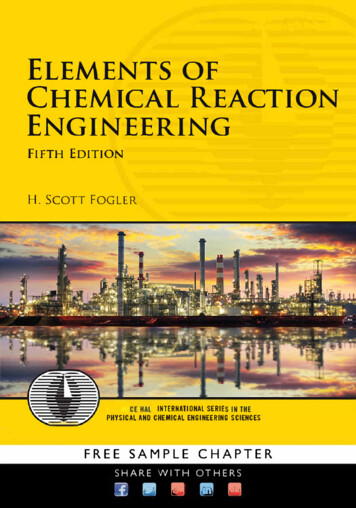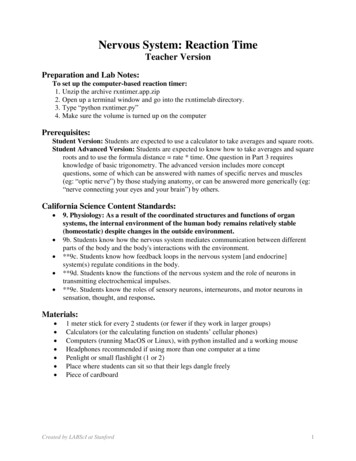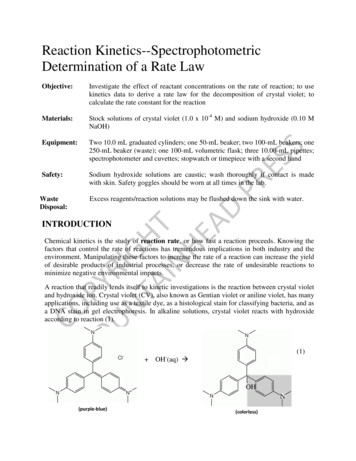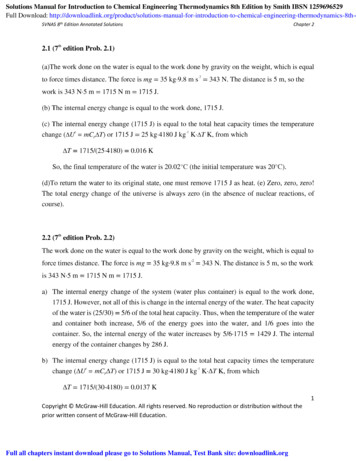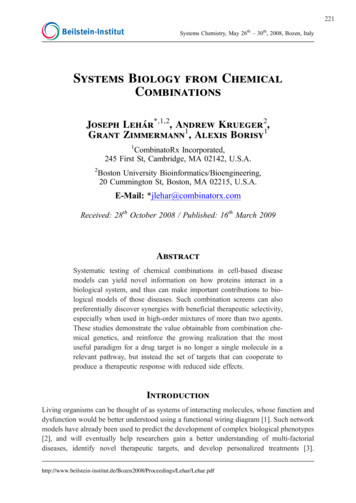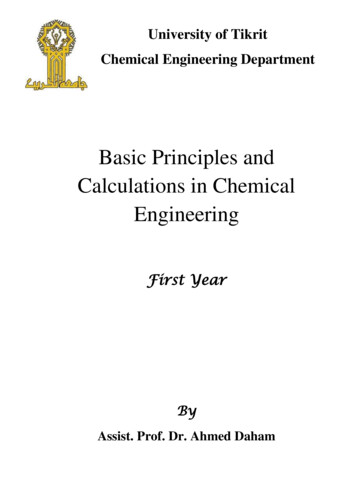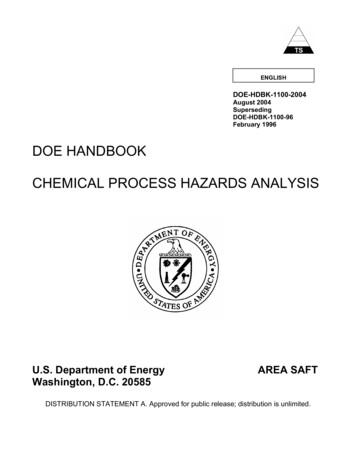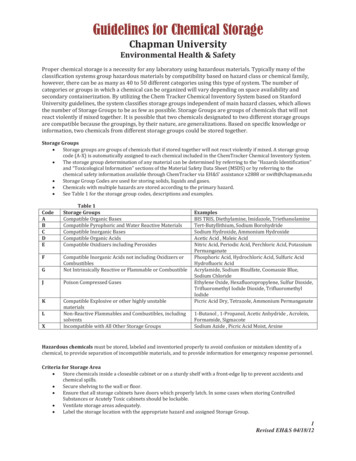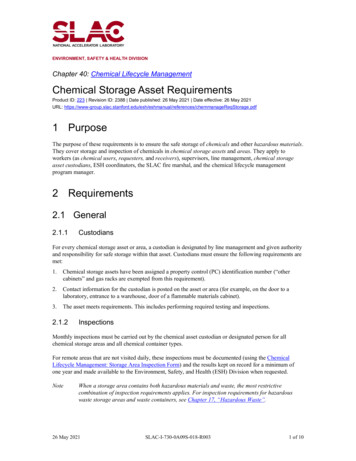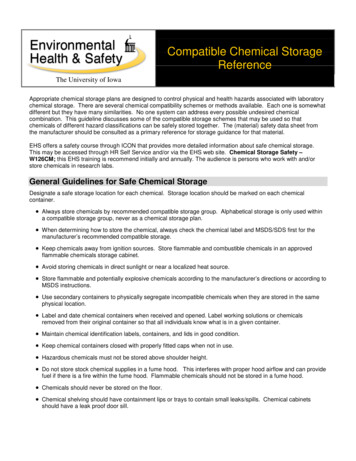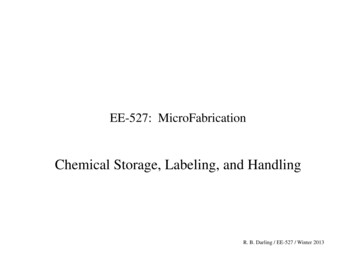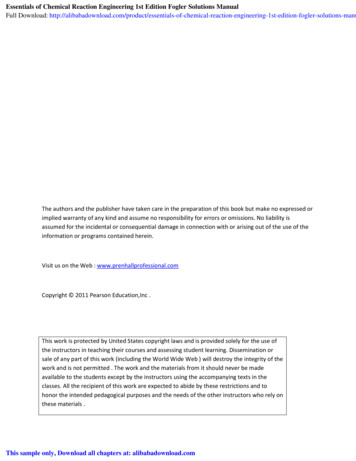
Transcription
Essentials of Chemical Reaction Engineering 1st Edition Fogler Solutions ManualFull Download: lutions-manuThe authors and the publisher have taken care in the preparation of this book but make no expressed orimplied warranty of any kind and assume no responsibility for errors or omissions. No liability isassumed for the incidental or consequential damage in connection with or arising out of the use of theinformation or programs contained herein.Visit us on the Web : www.prenhallprofessional.comCopyright 2011 Pearson Education,Inc .This work is protected by United States copyright laws and is provided solely for the use ofthe instructors in teaching their courses and assessing student learning. Dissemination orsale of any part of this work (including the World Wide Web ) will destroy the integrity of thework and is not permitted . The work and the materials from it should never be madeavailable to the students except by the instructors using the accompanying texts in theclasses. All the recipient of this work are expected to abide by these restrictions and tohonor the intended pedagogical purposes and the needs of the other instructors who rely onthese materials .This sample only, Download all chapters at: alibabadownload.com
Solutions for Chapter 2 - Conversion and Reactor SizingP2-1.This problem will keep students thinking about writing down what they learned every chapter.P2-2.This “forces” the students to determine their learning style so they can better use theresources in the text and on the CDROM and the web.P2-3.ICMs have been found to motivate the students learning.P2-4.Introduces one of the new concepts of the 4th edition whereby the students “play” with theexample problems before going on to other solutions.P2-5.This is a reasonably challenging problem that reinforces Levenspiels plots.P2-6.Straight forward problem alternative to problems 7, 8, and 11.P2-7.To be used in those courses emphasizing bio reaction engineering.P2-8.The answer gives ridiculously large reactor volume. The point is to encourage the student toquestion their numerical answers.P2-9.Helps the students get a feel of real reactor sizes.P2-10.Great motivating problem. Students remember this problem long after the course is over.P2-11.Alternative problem to P2-6 and P2-8.P2-12.Novel application of Levenspiel plots from an article by Professor Alice Gast at MassachusettsInstitute of Technology in CEE.CDP2-ASimilar to 2-8CDP2-BGood problem to get groups started working together (e.g. cooperative learning).CDP2-CSimilar to problems 2-7, 2-8, 2-11.CDP2-DSimilar to problems 2-7, 2-8, 2-11.SummaryP2-1 P2-2 P2-3AssignedOAAAlternatesDifficultyTime (min)153030
P2-4P2-5 P2-6P2-7P2-8P2-9 045Assigned Always assigned, AA Always assign one from the group of alternates,O Often, I Infrequently, S Seldom, G Graduate levelAlternatesIn problems that have a dot in conjunction with AA means that one of the problems, either theproblem with a dot or any one of the alternates are always assigned.TimeApproximate time in minutes it would take a B/B student to solve the problem.DifficultySF Straight forward reinforcement of principles (plug and chug)FSF Fairly straight forward (requires some manipulation of equations or an intermediatecalculation).IC Intermediate calculation requiredM More difficultOE Some parts open-ended.*Note the letter problems are found on the CD-ROM. For example A CDP1-A.Summary Table Ch-2Straight forward1,2,3,4,9Fairly straight forward6,8,11More difficult5,7, 12Open-ended12Comprehensive4,5,6,7,8,11,12Critical thinkingP2-8P2-1 Individualized solution.P2-2 (a) Example 2-1 through 2-3If flow rate FAO is cut in half.
v1 v/2 , F1 FAO/2 and CAO will remain same.Therefore, volume of CSTR in example 2-3,1 FA0 X2 rAF1 XrAV116.423.2If the flow rate is doubled,F2 2FAO and CAO will remain same,Volume of CSTR in example 2-3,V2 F2X/-rA 12.8 m3P2-2 (b) Example 2-4Levenspiel Plot4.543.5Fao/-ra32.521.510.5000.20.4Now, FAO 0.4/2 0.2 mol/s,Table: Divide each termX[FAO/-rA](m3)0.82FA 0rA0.8FA 0in Table 2-3 by 2.rA00.445Reactor 1V1 0.82m3V 1.770.72.530.84Reactor 2V2 3.2 m3X13.2X1By trial and error we get:X1 0.546andX2 0.8Overall conversion XOverall (1/2)X1 (1/2)X2 (0.546 0.8)/2 0.673P2-2 (c) Example 2-5(1) For first CSTR,at X 0 ;FA 0rAX2X21
FA0rA1.28m3at X 0.2 ;FA0rA.94 m3From previous example; V1 ( volume of first CSTR) .188 m3Also the next reactor is PFR, Its volume is calculated as follows0.5V20.2FAOdXrA0.247 m3For next CSTR,X3 0.65,FAOrA2 m 3 , V3 FAO ( X 3 X 2 )rA(2)Now the sequence of the reactors remainunchanged.But all reactors have same volume.First CSTR remains unchangedVcstr .1 (FA0/-rA )*X1 X1 .088NowFor PFR:X2V0.088FAOdXrA,By estimation using the levenspiel plotX2 .183For CSTR,.3m3
VCSTR2 FAO X 3 X 2rA0.1m3 X3 .316(3) The worst arrangement is to put the PFR first, followed by the larger CSTR and finally the smallerCSTR.ConversionX1 0.20X2 0.60X3 0.65Original Reactor VolumesV1 0.188 (CSTR)V2 0.38 (PFR)V3 0.10 (CSTR)Worst ArrangementV1 0.23 (PFR)V2 0.53 (CSTR)V3 0.10 (CSTR)For PFR,X1 0.2X1V10FAOdXrAUsing trapezoidal rule,XO 0.1, X1 0.1X1V1XOrAf XOf X10.21.28 0.98 m320.23m3For CSTR,For X2 0.6,FAO1.32m3 ,rAV2 FAOX2rAX 1 1.32(0.6 – 0.2) 0.53 m3For 2nd CSTR,For X3 0.65,FAOrA2m3 ,V3 0.1 m3P2-3 Individualized solution.P2-4 Solution is in the decoding algorithm given with the modules.P2-5
X00.1 0.2 0.4 0.6 0.7 0.83FAO/-rA (m ) 0.89 1.08 1.33 2.05 3.54 5.06 8.0V 1.6 m3P2-5 (a) Two CSTRs in seriesFor first CSTR,V (FAo/-rAX1) X X1 0.53For second CSTR,V (FAo/-rAX2) (X2 – X1) X2 0.76P2-5 (b)Two PFRs in seriesX1V0FAodXrAX2X1FAodXrABy extrapolating and solving, we getX1 0.62X2 0.84P2-5 (c)Two CSTRs in parallel with the feed, FAO, divided equally between two reactors. FANEW/-rAX1 0.5FAO/-rAX1V (0.5FAO/-rAX1) X1Solving we get, Xout 0.68P2-5 (d)Two PFRs in parallel with the feed equally divided between the two reactors.FANEW/-rAX1 0.5FAO/-rAX1By extrapolating and solving as part (b), we getXout 0.88P2-5 (e)
A CSTR and a PFR are in parallel with flow equally dividedSince the flow is divided equally between the two reactors, the overall conversion is the average of theCSTR conversion (part C) and the PFR conversion (part D)Xo (0.60 0.74) / 2 0.67P2-5 (f)A PFR followed by a CSTR,XPFR 0.50(using part(b))V (FAo/-rA-XCSTR) (XCSTR – XPFR)Solving we get, XCSTR 0.70P2-5 (g)A CSTR followed by a PFR,XCSTR 0.44 (using part(a))X PFRVX CSTRFAOdXrABy extrapolating and solving, we getXPFR 0.72P2-5 (h)A 1 m3 PFR followed by two 0.5 m3 CSTRs,For PFR,XPFR 0.50(using part(b))CSTR1: V (FAo/-rA-XCSTR) (XCSTR – XPFR) 0.5 m3XCSTR 0.63CSTR2: V (FAo/-rA-XCSTR2) (XCSTR2 – XCSTR1) 0.5 m3XCSTR2 0.72P2-6Exothermic reaction: A B CX00.200.400.450.500.600.800.90P2-6 )10.60.20.20.20.20.81.1
To solve this problem, first plot 1/-rA vs. X from the chart above. Second, use mole balance as givenbelow.CSTR:Mole balance:VCSTRFA0 XrA300mol / min 0.4 5mol / dm 3 . min VCSTR 24 dm3PFR:XV PFRFA 00Mole balance:dXrA 300(area under the curve)VPFR 72 dm3P2-6 (b)For a feed stream that enters the reaction with a previous conversion of 0.40 and leaves at anyconversion up to 0.60, the volumes of the PFR and CSTR will be identical because of the rate is constantover this conversion range.6VPFR.4FA 0dXrAFA0 .6dXrA .4P2-6 (c)VCSTR 105 dm3Mole balance: VCSTRFA0 XrAFA 0XrA.6.4
105dm 3300mol / minXrA0.35dm 3 min/ molUse trial and error to find maximum conversion.At X 0.70,1/-rA 0.5, and X/-rA 0.35 dm3.min/molMaximum conversion 0.70P2-6 (d)From part (a) we know that X1 0.40.Use trial and error to find X2.FA 0 X 2rAMole balance: VX1X2Rearranging, we getX20.40rAX2At X2 0.64,VFA 0X20.0080.40rA0.008X2Conversion 0.64P2-6 (e)From part (a), we know that X1 0.40. Use trial and error to find X2.X2Mole balance: V PFR72FA 00.40dXrAX2300At X2 0.908, V 300 x (area under the curve) V 300(0.24) 72dm3Conversion 0.908.0.40dXrA
P2-6 (f)See Polymath program P2-6-f.pol.P2-7 (a)VFS 0 XrSFS0 1000 g/hrAt a conversion of 40%Therefore V1rS0.150.15 (1000)(0.40)dm 3 hrg60 dm 3P2-7 (b)At a conversion of 80%,1rS0.8dm 3 hrgFS0 1000 g/hrTherefore V0.8 (1000)(0.80)640 dm 3P2-7 (c)XVPFRFS 00dXrSFrom the plot of 1/-rS Calculate the area under the curve such that the area is equal to V/FS0 80 / 1000 0.08X 12%For the 80 dm3 CSTR, V80 dm 3FS 0 XrSX/-rs 0.08. From guess and check we get X 55%
P2-7 (d)To achieve 80% conversion with a CSTR followed by a CSTR, the optimum arrangement is to have a CSTRwith a volume to achieve a conversion of about 45%, or the conversion that corresponds to theminimum value of 1/-rs. Next is a PFR with the necessary volume to achieve the 80% conversionfollowing the CSTR. This arrangement has the smallest reactor volume to achieve 80% conversion.For two CSTR’s in series, the optimum arrangement would still include a CSTR with the volume toachieve a conversion of about 45%, or the conversion that corresponds to the minimum value of 1/-rs,first. A second CSTR with a volume sufficient to reach 80% would follow the first CSTR.P2-7 (e)rskC S CCand C CK M CSrskC S 0.1 C S 0 C SK M CS1rsK M CSkC S 0.1 C S 0 C S0.1 C S 0CS0.0010.0010.001Let us first consider when CS is small.CS0 is a constant and if we group together the constants and simplify then1rsKMk1C S2CSk 2 Cssince CS KM1rsKMwhich is consistent with the shape of the graph when X is large (if CS is small X isk1C k 2 Cs2Slarge and as CS grows X decreases).Now consider when CS is large (X is small)As CS gets larger CC approaches 0:CC0.1 C S 0CS0.001 and C SCS 0
IfkC S CCthenK M CSrs1rsK M CSkC S CCAs CS grows larger, CS KMAnd1rsCSkC S CC1kCCAnd since CC is becoming very small and approaching 0 at X 0, 1/-rs should be increasing with CS (ordecreasing X). This is what is observed at small values of X. At intermediate levels of CS and X, thesedriving forces are competing and why the curve of 1/-rS has a minimum.P2-8Irreversible gas phase reaction2A B 2CSee Polymath program P2-8.pol.P2-8 (a)PFR volume necessary to achieve 50% conversionMole BalanceX2VFA0dXX 1 ( rA )Volume Geometric area under the curve of(FA0/-rA) vs X)V1400000 0.52100000 0.5V 150000 m3.P2-8 (b)CSTR Volume to achieve 50% conversionMole BalanceVVFA 0 X( rA )0.5 100000V 50000m3
P2-8 (c)Volume of second CSTR added in series to achieve 80%conversionV2V2FA0 ( X 2 X 1 )( rA )500000 (0.8 0.5)V2 150000m3P2-8 (d)Volume of PFR added in series to first CSTR to achieve80% conversionVPFR(1400000 0.3) (100000 0.3)2VPFR 90000m3P2-8 (e)For CSTR,V 60000 m3 (CSTR)Mole BalanceVFA0 X( rA )60000( 800000 X500000 ) XX 0.463For PFR,V 60000 m3 (PFR)Mole balanceXVFA0dX( rA )0X60000( 800000 X 100000)dX0X 0.134P2-8(f)Real rates would not give that shape. The reactor volumes are absurdly large.
P2-9Problem 2-9 involves estimating the volume of three reactors from a picture. The door on the side of thebuilding was used as a reference. It was assumed to be 8 ft high.The following estimates were made:CSTRh 56ftd 9 ftV πr2h π(4.5 ft)2(56 ft) 3562 ft3 100,865 LPFRLength of one segment 23 ftLength of entire reactor (23 ft)(12)(11) 3036 ftD 1 ftV πr2h π(0.5 ft)2(3036 ft) 2384 ft3 67,507 LAnswers will vary slightly for each individual.P2-10 No solution necessary.P2-11 (a)The smallest amount of catalyst necessary to achieve 80 % conversion in a CSTR and PBR connected inseries and containing equal amounts of catalyst can be calculated from the figure below.
The lightly shaded area on the left denotes the CSTR while the darker shaded area denotes the PBR. Thisfigure shows that the smallest amount of catalyst is used when the CSTR is upstream of the PBR.See Polymath program P2-11.pol.P2-11 (b)Calculate the necessary amount of catalyst to reach 80 % conversion using a single CSTR by determiningthe area of the shaded region in the figure below.The area of the rectangle is approximately 23.2 kg of catalyst.P2-11 (c)The CSTR catalyst weight necessary to achieve 40 % conversion can be obtained by calculating the areaof the shaded rectangle shown in the figure below.The area of the rectangle is approximately 7.6 kg of catalyst.
P2-11 (d)The catalyst weight necessary to achieve 80 % conversion in a PBR is found by calculating the area of theshaded region in the figure below.The necessary catalyst weight is approximately 22 kg.P2-11 (e)The amount of catalyst necessary to achieve 40 % conversion in a single PBR can be found fromcalculating the area of the shaded region in the graph below.The necessary catalyst weight is approximately 13 kg.
P2-11 (f)P2-11 (g)For different (-rA) vs. (X) curves, reactors should be arranged so that the smallest amount of catalyst isneeded to give the maximum conversion. One useful heuristic is that for curves with a negative slope, itis generally better to use a CSTR. Similarly, when a curve has a positive slope, it is generally better to usea PBR.P2-12 (a) Individualized SolutionP2-12 (b) 1) In order to find the age of the baby hippo, we need to know the volume of the stomach. Themetabolic rate, -rA, is the same for mother and baby, so if the baby hippo eats one half of what themother eats then Fao (baby) ½ Fao (mother). The Levenspiel Plot is shown:Autocatalytic .20.4Conversion0.60.8
VbabyFaoXrA1.36*0.34 0.23m32Since the volume of the stomach is proportional to the age of the baby hippo, and the vo
P2-1 Individualized solution. P2-2 (a) Example 2-1 through 2-3 If flow rate F AO is cut in half. v 1 v/2 , F 1 F AO /2 and C AO will remain same. Therefore, volume of CSTR in example 2-3, 6.4 3.2 2 1 2 1 1 0 1 A A A r F X r F X V If the flow rate is doubled, F 2 2F AO and C AO will remain same, Volume of CSTR in example 2-3, V 2 F 2 X/-r A 12.8 m 3 P2-2 (b) Example 2-4 Now, F AO 0 .
